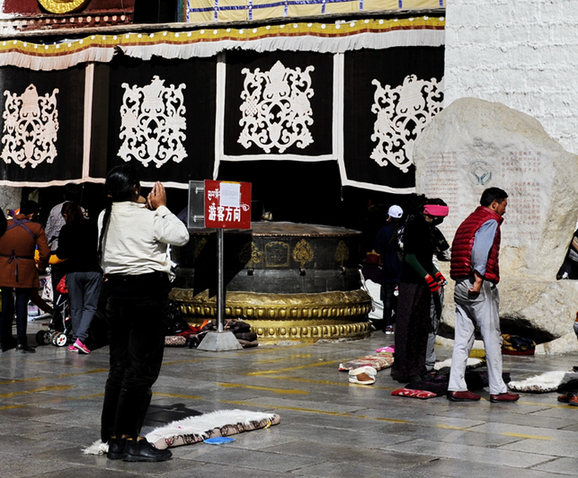Impressive Tibet
- By Casimir Kouadio
 0 Comment(s)
0 Comment(s) Print
Print E-mail Beijing Review, January 3, 2017
E-mail Beijing Review, January 3, 2017
|
|
|
The Jokhang Monastery in Lhasa, Tibet Autonomous Region (XINHUA) |
After nearly 5 hours of flight from Beijing, our plane lands at Gonggar Airport in Lhasa, Tibet Autonomous Region. I am standing in China's extreme southwestern corner, almost 4,000 km from the capital. The terrain here is mountainous. As soon as I step onto the ground, a strange atmosphere and very dry and strong winds greet me, and I am struck by an intense heat. I have a hard time standing straight. My heart starts beating wildly, a fever-like feeling grips me, and I feel out of breath and dizzy. Tibet's altitude is already taking its toll.
Our first stop is the Sheraton Hotel, one of the most prestigious hotels in the city. There, things do not look good either. It is difficult to eat, difficult to walk, difficult to shower, difficult to lie down and sleep. Without transition, heat makes way for cold and vice versa. Temperatures fall from 28 degrees Celsius during the day to 14 degrees Celsius at night. I feel physically diminished throughout my stay.
After three days of this physical torture, we head for Nyingchi, located more than 500 km east of Lhasa, at 3,100 meters altitude. We can still feel the effects of the rarefied atmosphere, but things are much better. I even allow myself to go out for an evening walk.
Covering an area of 1.23 million square km, Tibet is lifting itself out of underdevelopment.
Lhasa and Nyingchi are modern cities focused on tourism. Besides its temples, museums and other religious buildings, the booming region of Tibet today takes pride in its bridges and 500-meter-plus tunnels that pierce mountains. It's also a region with beautiful modern villages high up in the mountains, which attract tourists from around the world.
In the agriculture and livestock industries, the government of Tibet Autonomous Region has initiated projects featuring modern and proven techniques so that local people can enjoy better food products. All this is made possible despite the region being located on a plateau at an average height of 3,800 meters above sea level. Tibet has its own university and top-class technical and vocational schools as well as highways and airports in some cities.
Superbly perched high on a 100-meter hill overlooking Lhasa, the Potala Palace is beyond impressive. This magnificent burgundy and white palace immediately catches the eyes of any first-time visitor and is the pride of the people of Lhasa. From far and near, the building does not show its age. Originally built in the 7th century, this architectural masterpiece comprising 2,000 rooms is part of China's historical heritage under state protection. Having been turned into a museum run by Buddhist clerics, it receives flocks of visitors—an average of 5,000 per day in every season except winter, when the figure falls to 1,000.
Not far away lies Jokhang Monastery, with its striking colors and architecture, where faithful Buddhists come to pray day and night.
Buddhism is Tibet's main religion. Over 92 percent of the region's population is Buddhist. Carved or crafted items representing the Buddha—recipients of the prayers of the faithful-can be seen all over Lhasa, and most of the city's shops sell monks' robes and other such regalia. Buddhism, however, is not imposed on Tibet. Everyone is free to choose his or her religion.
The author is a journalist from Cote d'Ivoire who recently visited China







Go to Forum >>0 Comment(s)